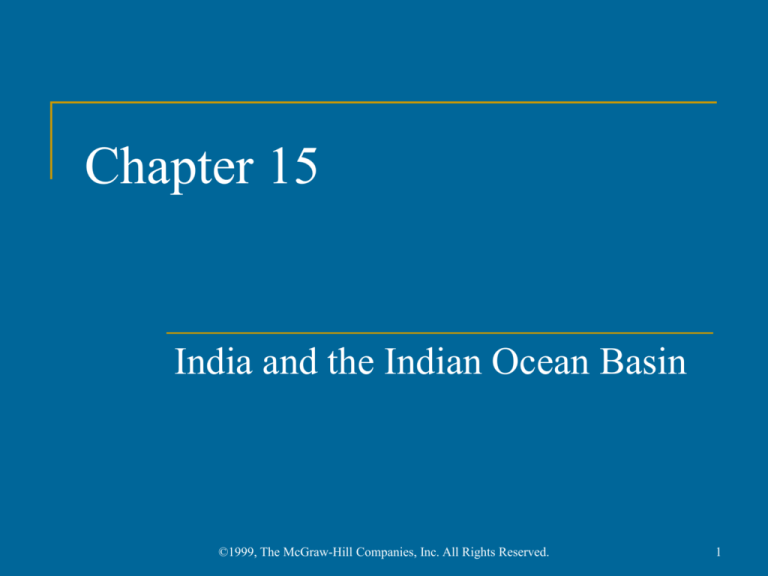
Chapter 15
India and the Indian Ocean Basin
©1999, The McGraw-Hill Companies, Inc. All Rights Reserved.
1
India After the Fall of the Gupta
Dynasty
Gupta state collapsed mid-sixth century
Chaos in northern India
Local power struggles
Invasions of Turkish nomads, absorbed into Indian
society
©1999, The McGraw-Hill Companies, Inc. All Rights Reserved.
2
King Harsha (r. 606-648 C.E.)
Temporary restoration of unified rule in north
India
Religiously tolerant
Buddhist by faith
Assassinated, no successor able to retain control
©1999, The McGraw-Hill Companies, Inc. All Rights Reserved.
3
©1999, The McGraw-Hill Companies, Inc. All Rights Reserved.
4
Introduction of Islam to Northern
India
Muslim merchants formed small communities in all
major cities of coastal India
Turkish migrants and Islam: Turks convert to Islam in
tenth century
Some moved to Afghanistan and established an
Islamic state
Mahmud of Ghazni, Turk leader in Afghanistan,
made expeditions to northern India
©1999, The McGraw-Hill Companies, Inc. All Rights Reserved.
5
The Sultanate of Delhi
Mahmud's successors conquered north India, 1206
Established an Islamic state known as the sultanate of
Delhi
Sultans' authority did not extend far beyond the
capital at Delhi
Islam began to have a place in India
©1999, The McGraw-Hill Companies, Inc. All Rights Reserved.
6
©1999, The McGraw-Hill Companies, Inc. All Rights Reserved.
7
Agriculture in the Monsoon World
The monsoons (rains in spring and summer)
Irrigation systems were needed for dry months
No big river in south India; waterworks included dams,
reservoirs, canals, wells
Stored rainwater in large reservoirs connected to canals
Population growth: 53 million in 600 C.E. to 105 million in
1500 C.E.
Urbanization took place in Delhi and other large port cities
©1999, The McGraw-Hill Companies, Inc. All Rights Reserved.
8
The Trading World of the Indian Ocean
Basin, 600-1600 C.E.
©1999, The McGraw-Hill Companies, Inc. All Rights Reserved.
9
Trade and Economic Development in
Southern India
Indian regional economies largely self-sufficient
Certain products traded throughout subcontinent
Iron, copper, salt, pepper
Southern India profits from political instability in
north
©1999, The McGraw-Hill Companies, Inc. All Rights Reserved.
10
Temples and Indian Society
Hindu temples served as economic and social centers
Possessed large tracts of land, hundreds of employees
Temple administrators were to maintain order,
deliver taxes
Served as banks; engaged in business ventures
©1999, The McGraw-Hill Companies, Inc. All Rights Reserved.
11
Cross-Cultural Trade in the Indian
Ocean Basin
Dhows and junks--large ships involved in maritime
trade in Indian Ocean
Trade goods
Silk and porcelain from China
Spices from southeast Asia
Pepper, gems, pearls, and cotton from India
Incense and horses from Arabia and southwest Asia
Gold, ivory, and slaves from east Africa
©1999, The McGraw-Hill Companies, Inc. All Rights Reserved.
12
Specialized production
Production of high-quality cotton textiles thrived
Other specialized industries: sugar, leather, stone,
carpets, iron and steel
©1999, The McGraw-Hill Companies, Inc. All Rights Reserved.
13
Challenges to Caste and Society
Caste helped to integrate immigrants (Turks, Muslim
merchants) into Indian society
Caste and social change: guilds and sub castes (jatis)
Expansion of caste system, especially to southern
India
©1999, The McGraw-Hill Companies, Inc. All Rights Reserved.
14
Development of Hinduism
Hinduism predominated in southern India, Islam in
the north
Promise of salvation
Especially popular in southern India, spreads to north
©1999, The McGraw-Hill Companies, Inc. All Rights Reserved.
15
Islam and its appeal
Conversion to Islam occurred in a slow and gradual
way
Some converted for improving their lower social
statuses
Often an entire caste or sub caste adopted Islam en
masse
By 1500, about 25 million Indian Muslims (1/4 of
population)
©1999, The McGraw-Hill Companies, Inc. All Rights Reserved.
16
Sufis
Personal, emotional, devotional approaches to
Islam
Important missionaries of Islam to India
Some flexibility regarding local customs
©1999, The McGraw-Hill Companies, Inc. All Rights Reserved.
17
Indian Influence in Southeast Asia
Indian merchants brought their faiths to southeast
Asia
Ruling elite of southeast Asia adapted some Indian
political traditions
The states sponsored Hinduism and Buddhism
Showed no interest in Indian caste system
©1999, The McGraw-Hill Companies, Inc. All Rights Reserved.
18
Angkor (889-1431 CE)
Kingdom built by Khmers at Angkor Thom, later
Angkor Wat
The city was a microcosmic reflection of Hindu
world order
Turned to Buddhism during the twelfth and
thirteenth centuries
©1999, The McGraw-Hill Companies, Inc. All Rights Reserved.
19
©1999, The McGraw-Hill Companies, Inc. All Rights Reserved.
20
©1999, The McGraw-Hill Companies, Inc. All Rights Reserved.
21
Islam in Southeast Asia
Early populations of Muslim traders
Increasing popularity with Sufi activity
Many convert, retain some Hindu or Buddhist
traditions
©1999, The McGraw-Hill Companies, Inc. All Rights Reserved.
22
State of Melaka
Dominated maritime trade routes
Mid-fifteenth century converts to Islam
HOMEWORK: ISLAM READING PDF ON MY
WIKI
©1999, The McGraw-Hill Companies, Inc. All Rights Reserved.
23






